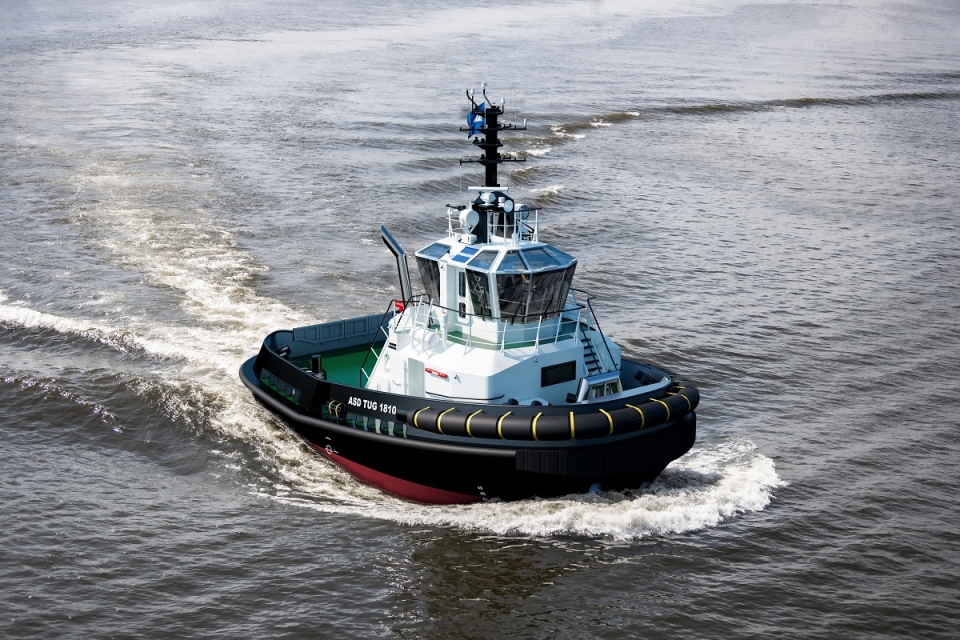Damen Shipyards has unveiled the latest vessel in its Compact Tugs product platform. Apart from being compact, the ASD Tug 1810 – 18.25 metres x 10.23 metres – has been designed with safety and minimal maintenance in mind.
Damen has placed great emphasis on safety in the development of the ASD Tug 1810. The vessel is able to draw on technology already proven on board the other vessels in the Compact Tugs range.
Siebe Cieraad, Damen’s product portfolio manager tugs explains: ‘With it being a priority for us, you see safety return time and again throughout the entire design of the tug. For example, the vessel boasts a high freeboard, keeping water on deck to a minimum. It also has the tumblehome so characteristic of the Compact Tugs range, enabling it to get safely up close when assisting a vessel.’
The operation is further aided by the application of ergonomically designed consoles and a 360-degree view from the wheelhouse, enabling operators to see what’s happening both fore and aft. The operators further benefit from the use of Damen Safety Glass; in the event of a towing line snapping, this shatterproof glazing ensures that observers on the bridge are protected.
Also read: Damen delivers first-of-series CSD600
Clutter free
Like the other vessels in the range, the ASD Tug 1810 features clutter free decks. As Cieraad points out, during an operation, crew need to be focused on what is going on around them and not be distracted by potential tripping hazards on deck.
‘To help the crew maintain their focus during their work, and to help the captain gain a clear view on what’s taking place, we’ve tried to keep the decks as clear as possible, and keep the potential of tripping to an absolute minimum.’
Also read: Damen cuts steel for Ta San Shang Marine’s new CSOV
Minimal maintenance
Most of the items conventionally found on deck have been incorporated into the deck house and bulwark. This includes the Damen Marine Components winch, which has an important role to play in the vessel’s efficient performance. The winch is installed in the deck house so that towing operations both fore and aft can be undertaken with a single winch.
‘In addition to protecting the crew, this also helps protect the equipment,’ says Cieraad. ‘With the winch placed in this location, it is afforded shelter from the elements, minimising the needs for maintenance.’
The same applies to the tug’s closed loop cooling system. In this, fresh water runs in a series of channels on the underside, radiating heat away from the vessel. ‘As such, no sea water enters the vessel and the internal system is protected from the abrasiveness of salt water. As a result, it becomes possible to reduce docking intervals, sometimes by as much up to seven years.’
Also read: KT Marine orders Fast Ferry 4212 from Damen
Damen Twin Fin skeg
The ASD Tug 1810 also features the patented Damen Twin Fin skeg. Originally installed on the RSD Tug 2513, the skeg has now become a feature on all Damen’s Compact Tugs. It has demonstrated its ability to boost course keeping, manoeuvrability and predictable sailing behaviour during operations, improving both efficiency and safety.

Small, but powerful
Where the Compact Tugs portfolio really excels is its ability to answer the challenge of increasingly large seagoing vessels in ports. This creates a seemingly paradoxical situation whereby a tug is required to have more power, and yet has less space to operate in.
With 30 tonnes of bollard pull ahead and 28 tonnes bollard pull astern, and at just over 18 metres in length, the ASD Tug 1810 is set to meet this challenge head on.
This is achieved, for example, by the electric power generation system installed in the Compact Tugs range. Rather than the typical arrangement featuring two diesel generator sets, the system includes two shaft generators, one fitted to each power train, and a back-up diesel generator. This diesel generator can also be used when the vessel is alongside a quay where there is no shore connection available.
Cieraad explains: ‘The system draws on power from the main engines to create electricity. With this, there is no requirement for a third diesel engine to provide electrical power when the vessel is sailing.’
This provides a number of benefits. For one thing, it results in a reduction in fuel consumption and, therefore, emissions, improving the vessel’s sustainability performance. It also reduces the amount of maintenance that typically has to be carried out on a conventional generator. Crucially, this configuration enables Damen to produce a more compact design.
Minimal noise and vibration
Despite its compact nature, Damen has designed the ASD Tug 1810 to produce minimal noise and vibration. The four-person accommodation, for example, is well insulated and finished with modern, durable linings, while the wheelhouse features a floating floor and acoustical ceiling.
In addition, IMO Tier III compliance results from the installation of a Damen Emission Reduction System. This modular optional feature is an in-house developed exhaust gas aftertreatment solution that reduces the NOX emissions from the vessel. Fitted in the existing exhaust silencers, the system can be retrofitted to the vessel at any time.
Also read: Damen explores Zeabuz tech for autonomous sailing
Remote monitoring
In a further boost to efficiency, the tug will be delivered with all the necessary equipment to be remotely connected to Damen’s award winning Internet of Things (IoT) solution Triton.
‘With this, it becomes possible to closely monitor the vessel’s performance. The benefits to this are many and varied. For example, Triton can help determine the optimal speed and route for reducing fuel consumption and emissions.’
Damen is also developing zero emission or carbon neutral versions of its compact ASD Tugs.
All pictures by Damen.








